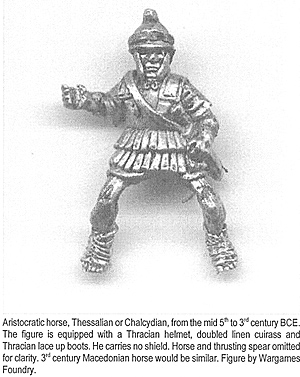
Equipment - Offensive
In general it seems that the arms and armor of a hippeis varied from state to state, but also within the state amongst individuals as one would expect from an aristocratic group. The cavalryman of ancient Greece carried either javelins or a lance for his main offensive arms, and sometimes both, as can be seen for example on the Panaitios relief in Athens. He also usually carried a sword as a secondary weapon.
Aristocratic horse, Thessalia nor Chalcydian, from the mid 5th to 3rd century BCE. The figure is equipped with a Thracian helmet, doubled linen cuirass and Thracian lace up boots. He carries no shield. Horse and thrusting spear omitted for clarity. V century Macedonian horse would be similar. Figure by Wargames Foundry.
When carrying javelins, it appears that usually two or three were carried. The javelins are sometimes shown in art with throwing loops, which were held around the fingers and gave the throw greater range and accuracy.
The lance used by cavalry was about the same length as a hoplite spear, around eight feet long, and is sometimes depicted with a butt spike. Sometimes two are carried.
Most sword types were used, though the macheira or kopis, a curved slashing saber, was more common than the xiphos, which was better suited to stabbing.
Equipment - Defensive
Throughout our period breastplates were common, although their frequency of use and type fluctuated with the times. Some cavalry is depicted with very little armor, and these may well have been prodromoi or scouts, or simply depict hippeis who preferred to fight unarmored. Unlike hoplite breastplates, cavalry breastplates were quite often composed purely of bronze - for example the bell-cuirass which flanged from the waist - rather than the bronze-linen composite cuirasses more common to the hoplites.
Helmets were usually worn. At the start of our period it seems cavalry troopers availed themselves of the closed-type helmets, such as the Corinthian and Thracian forms. In a similar manner to the evolution of infantry head-gear, the cavalry adopted increasingly open forms of helmet as the fifth century progressed, such as the Pilos and Boeotian types. Although there are a few depictions of mounted troopers wearing greaves, these tend to be at the very start of our period and probably show mounted hoplites.
Thick leather boots were nearly always worn. Xenophon recommends extra armor be worn by the hippeis on the arms and thighs, but it is difficult to assess how common these were. Horse armor was rare. Xenophon recommends its use for the horse's head, breast and thighs. A Greek coin, no.471, which is Thessalian, shows some horse armor. Additionally, some horse head guards have been found at Olympia, as well as in Sicily.
Greek cavalry appear not to have used shields. There are some depictions of men mounted on horses carrying an aspis, but these may well have been mounted hoplites, although at least one of these shows the rider in combat (Bologna 363, see Spence, 238) There is also a depiction of some horsemen holding horses by the reins and armed with a pelte (a small shield, either round or crescent-shaped) from about 500 at the Michigan State University (see IG Spence, 235). Shields were being used earlier than is often thought in Magna Graecia the Spartan colony of Taras was using them by the fifth century as shown on two Greek coins (GC 335, 797), and there are many such representations from the fourth century.
(The Tarrantines may have pioneered the use of large light shields. The Romans adopted them from Taras, and the word "Tarrantine" seems to have entered the 3rd century military lexicon as meaning shielded horse. Hence "Tarrantine style" appears to mean fighting as shielded skirmishing horse. Ed.)
More Ancient Greek Cavalry A Re-Assessment
-
Preface and Introduction
The Greek Hippeis
The North and South
Training
Organization
Equipment
Combat Effectiveness
Conclusion
Back to Strategikon Vol. 1 No. 4 Table of Contents
Back to Strategikon List of Issues
Back to MagWeb Master Magazine List
© Copyright 2002 by NMPI
This article appears in MagWeb (Magazine Web) on the Internet World Wide Web. Other military history articles and gaming articles are available at http://www.magweb.com